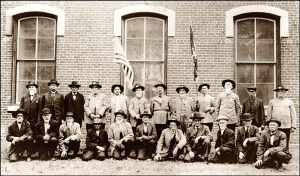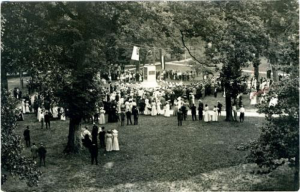The Most Generous White Supremacist
Julian Shakespeare Carr
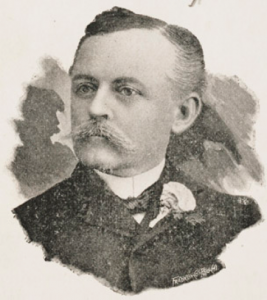
General Julian S. Carr[1]
“Julian Carr was not merely “a man of his times,” but rather an architect of his times. He was an enemy of enlightenment and democracy whose rhetoric and actions, both then and now, cast dark shadows over the civil and political life of the state and retard our ability to move forward from the legacies of slavery and Jim Crow. Continuing to celebrate those who most actively sought to divide us is a surefire way to guarantee we remain so deeply divided.” [3]
Julian Carr is no lighthearted subject on the Chapel Hill Campus. The identity or portrayal of Julian S. Carr is mangled but derived by his philanthropic endeavors, business success, and documented white supremacist views.
Background
Julian Carr was born on October 13th in 1845 and passed away April 29th, 1924. His life is well documented, as he was a wealthy and prominent businessman and philanthropist. He was born in Chapel Hill and attended the University of North Carolina from 1862-18
64. After college he joined the North Carolina Cavalry as a private to serve in the Confederate Army. He did not go up in ranks within the Army, but he eventually became a Commander of the United Confederate Veterans (UCV) in North Carolina. A league of men that served in the Confederate Army, and was created with the purpose of being a social and historical group. Because of his ranking in the UCV, Carr became known as General Carr, which was even engraved on his gravestone.
Carr finished school and went on to become a pioneer in the tobacco farming industry. He began his endeavor in Durham, NC and by 1898 was able to sell his business for three million dollars to the American Tobacco Company.[4] Following his tobacco achievements, General Carr went on to develop businesses in textile manufacturing, along with electrical power, and expanded his philanthropic contributions.
Business
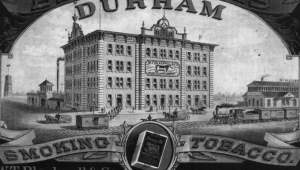
“Old Bull” Bldg. Depiction, 1874 -1879, “Bull City Business Bonanza” by Ben and Snow Roberts[5]
Julian Carr successfully attempted dozens of businesses , but his most successful was his branding of “Bull Durham” tobacco which is now recognized worldwide. In 1870, he officially joined two other partners in the creation of this Smoking Tobacco Company – and much of the success of the company is attributed to Carr’s advertising abilities. The three began construction of their first factory building, the “Old Bull” in the 1870s[6]:
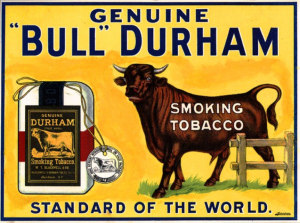
W.T. Blackwell Co. advertisement for their world famous “Bull Durham” tobacco[7]
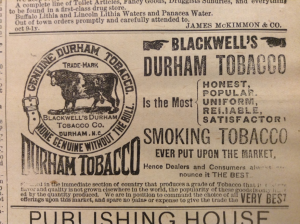
An actual newspaper ad for Bull Durham tobacco from an old Durham newspaper[8]
The Building
Julian Carr is the only person to have served on the Board of Trustees at both the University of North Carolina and at Duke University. Therefore, it is not surprising to find a building named after him on both campuses.[9]
Located on UNC- Chapel Hill’s central campus on Cameron Avenue is the Carr building. The Carr Building is one of two buildings on campus made completely possible by the donations of one donor. The Carr Building was known as a disaster from the start. It’s construction went over budget and took much longer than expected, but still was a notably badly built building. It was designed by architect company “Zachary and Zachary,” and has received more renovations than necessarily noted – at least five were documented within 50 years of the buildings opening.[10]
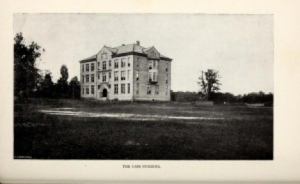
The Carr Bulding, 1902. Courtesy of the North Carolina Collection, UNC-Chapel Hill.[11]
The Carr Building was completed in June of 1900 with the intention of being a dormitory, but now presides as a decrepit administrative office building.[12] The building was named after Julian Carr as a memorial to his service in the Confederate Army and his large contributions to the school – but note that he was the sole individual to fund the building, so it was his decision on what to name the building.[13] No discussion on changing the namesake of the building has been documented by the University or city.
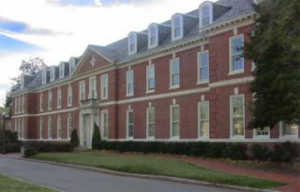
Department of History, Carr Building, Duke University’s East Campus[14]
Duke University’s Carr Building is a different story. The school describes the building as “A three-story Georgian style red Baltimore brick building, trimmed in Vermont marble, and with a Buckingham slate roof.” A description so eloquently stated can not be found for the UNC building. The Duke – Carr Building was finished in 1927 but was originally named the “Classroom Building.” It was not renamed the “Carr Building” until three years later in 1930.[15]
Contributions
Julian Carr was an incredibly generous man; some historians say he literally donated a fortune between his beloved Methodist Church, Confederate Veterans group and his college – UNC – Chapel Hill. Embedded below is a scan of a document from 1908 showcasing his reputation as a substantial donor to the school. It is a letter to James Kenan explaining Carr’s anxiousness to meet with him and donate to one of Chapel Hill’s monuments.
Folder 876: May 1908-September 1909: Scan 1
Before Duke University was “Duke,” it was named Trinity College and was a little struggling school. Before becoming Duke, Carr was already donating to the school, in increments of $10,000, a large sum of money at the time. With the donation of Blackwell Park (62.5 acres), Trinity College was able to move to Durham, and Blackwell Park became Duke’s East Campus. Now Duke University is a thriving school, known by families across America and even the globe. According to “Open Durham,” many of Carr’s contributions to the school and city are forgotten because of his white supremacist views.[16]
His most interesting contribution is to the city of Carrboro – located directly next to Chapel Hill. Much information can be found on the history of Carrboro, but in most pamphlets, books, or articles you will not see the name Julian Carr. The town of Carrboro is literally named after Julian Carr for sharing electricity to the town when their last mill was shut down, yet he is rarely referenced because of his white supremacist history. In a Daily Tar Heel article, former mayor of Carrboro requests a name change for the city and argues that “Carrboro” does not represent the town’s values. Carrboro has a reputation of being an accepting and diverse community, which do not fall in line with Julian Carr.[17] http://www.dailytarheel.com/article/2016/04/former-mayor-requests-carrboro-name-change
most pamphlets, books, or articles you will not see the name Julian Carr. The town of Carrboro is literally named after Julian Carr for sharing electricity to the town when their last mill was shut down, yet he is rarely referenced because of his white supremacist history. In a Daily Tar Heel article, former mayor of Carrboro requests a name change for the city and argues that “Carrboro” does not represent the town’s values. Carrboro has a reputation of being an accepting and diverse community, which do not fall in line with Julian Carr.[17] http://www.dailytarheel.com/article/2016/04/former-mayor-requests-carrboro-name-change
Context : North Carolina During the Times of Julian Carr
Timeline
(1865-1877) The Reconstruction Period
- African American men were elected to North Carolina Offices
(1865) Thirteenth Amendment Abolishes Slavery
(1868) Fourteenth Amendment Recognizes Blacks as Citizens
(1870) Fifteenth Amendment Granted African American Men the Right to Vote
(1896) Establishment of Civil Rights Movement in North Carolina
(1898) Wilmington Race Riot
(1900) North Carolina passed an Amendment preventing African Americans from voting
(1913) Silent Sam Dedication
(Early 1930’s) African Americans began Fighting for Admission into College
- First documented case – Thomas Hocutt into UNC Pharmacy School
Silent Sam Statue
The original purpose of the Silent Sam Memorial was not what it has become today. The memorial was a gift from the United Daughters of the Confederacy in honor of students who joined the Confederate Army during the Civil War. The University writes “The North Carolina division of the United Daughters of the Confederacy commissioned this memorial in 1913 in honor of the UNC alumni who “answered the call of duty” as Confederate soldiers in the Civil War.” Instead of memorializing “those who served,” according to students on campus today it memorializes those who oppressed, those who disrespected and enslaved peoples on non-Caucasian descent. The student” Silent Sam Coalition” was formed, and their presence can be found on twitter, instgram and at the statue itself. The University has acknowledged this pain, and writes on their website (www.unc.edu) “The monument is perhaps the most controversial memorial on campus. Many view it as a glorification of the Confederacy and thus a tacit defense of slavery, and believe it should be removed from campus. Many others feel that such a removal would do more harm than good by denying the reality of this period of UNC’s (and the nation’s) history.” The school is facing harsh restrictions on monument removal or renaming as well as pressure from donors and students, no decision has been made on the statue as of yet, and none is expected.[19]
What does this have to do with Julian Carr you ask? Well the answer is – everything. Up to this point I have tried to note the positives of Julian Shakespeare Carr, but now I must touch on his intolerant views. Below I will attach the speech General Carr gave at the unveiling and dedication of the Silent Sam statue – the speech that has made Carr such a prominent topic in the Black Lives Matter and equality movements happening right now.
The document below shows that this speech was approved before its delivery by the University:
Folder 988: 26-31 May 1913: Scan 14
In the very first line Carr writes “There are no words that I have been able to find in the vocabulary of the English language that fittingly express my feelings in this presence of this occasion.” His intentions in the sentence were to express his gratitude towards those students that served in his beloved Confederate Army – especially from his favorite college – UNC. He then goes on to say “The present generation, I am persuaded, scarcely takes note of what the Confederate soldier meant to the welfare of the Anglo Saxon race during the four years immediately succeeding the war, when the facts are that their courage and steadfastness saved the very life of the Anglo Saxon race in the South. This is where the controversy really begins. His white supremacist views start to leak through, and become b=more about preservation of the Anglo Saxon instead of honoring those who honored their need to serve. Directly after this quote Carr says “One hundred yards from where we stand, less than ninety days perhaps after my return from Appomattox, I horse-whipped a negro wench until her skirts hung in shreds.” He asks to be “pardoned” for this one “allusion” but calls it a “pleasing duty” to whip this woman in front of a hundred Federal soldiers.[20]
A man with a life long history of generous donations and philanthropic endeavors finds whipping a “negro woman” a “pleasing duty” – the most generous white supremacist.
The Silent Sam statue is more than a topic of interest on Chapel Hill Campus right now. Groups have formed such as the “Real Silent Sam Coalition.” Other groups such as the Black Lives Matter advocates have joined in on the efforts. There have been multiple sit ins, forums and boycotts to support the removal of the statue. The removal is nowhere in the near future, but these efforts have more than succeeding in drawing attention to the statue and how it affects the students on campus.
The Faculty of the Department of History has released a public statement urging UNC to remove the Silent Sam monument. The noted it does not accurately portray the views of all faculty and students on campus, therefore does not allow for the feeling of inclusion on campus for some. The recommend the statue be moved and deemed a historical artifact.[21]
The statue and progression through time and protest can be seen in the images below:
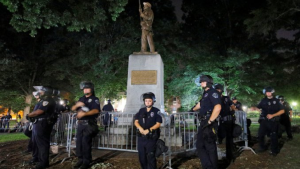
Police wearing riot gear guard a statue of a Confederate soldier nicknamed Silent Sam on the campus of the University of North Carolina during a demonstration for its removal in Chapel Hill, North Carolina, U.S. August 22, 2017. REUTERS/Jonathan Drake
“Carr-Washing”
“Carr-washing” has become a popular trend in Durham and Chapel Hill, as Julian Carr’s name is taken off buildings, such as the Durham Performing Arts Center. His speeches, such as the Silent Sam Memorial speech, have sparked a movement. His speeches have been quoted at Black Lives Matter Movements, and secondhand sources say it was referenced at the University of Virginia march. Carr’s slave count is undocumented other than those employed by his companies, but his White Supremacist ties are undeniable.
Who is Julian Carr?
I leave the opinion of Julian Carr to the interpretation of the researcher or reader. A UNC history professor noted above, Professor Roseman, says “look beyond Julian Carr’s 1913 Silent Sam speech”. He expresses that Carr is a “man of his times” and that his Silent Sam speech overshadows his accomplishments. Fellow colleague of Roseman, William Sturkey, released his opinion in a Herald Sun article strongly disagreeing. He disagrees that this one speech changed opinions on Julian Carr. He documented a life-long history of Carr’s white supremacist actions including his stereotyping of African Americans as violent criminals lusting after white women. Carr was also against the right for black North Carolinians to vote. One of Carr’s most notable White Supremacist actions was his aid in the take down of the “Fusion Movement.” He was able to acquire the News & Observer newspaper to influence an overthrow, which also contributed to the Wilmington Massacre of 1898 where over 60 African Americans were murdered – what Carr claimed was a “grand and glorious event.” He also used this description in his Silent Sam Speech. In summation Professor Roseman argues Carr is a “man of his times” whereas Sturkey argues Carr is an “architect of his times.”[22]
What do you think?
The University of North Carolina aims to inform the public with facts about Julian Shakespeare Carr, along with other civil war monuments on campus. The UNC library online resource now exhibits a page specifically designed on researching campus monuments. They have pages specifically for the Silent Sam monument and Julian Carr’s influence.
Footnotes
[1] “Carr, Julian Shakespeare.” Carr, Julian Shakespeare | NCpedia. Accessed November 5, 2017. https://www.ncpedia.org/biography/carr-julian-shakespeare.
[2] Sturkey, William. “Carr was indeed much more than Silent Sam.” Heraldsun. Accessed November 11, 2017. http://www.heraldsun.com/opinion/article181567401.html.
[3] Sturkey, William. “Carr was indeed much more than Silent Sam.” Heraldsun. Accessed November 11, 2017. http://www.heraldsun.com/opinion/article181567401.html.
[4] “Carr, Julian Shakespeare.” Carr, Julian Shakespeare | NCpedia. Accessed November 5, 2017. https://www.ncpedia.org/biography/carr-julian-shakespeare.
[5] “BLACKWELL’S DURHAM TOBACCO / AMERICAN TOBACCO CO.” BLACKWELL’S DURHAM TOBACCO / AMERICAN TOBACCO CO. | Open Durham. Accessed October 20, 2017. http://www.opendurham.org/buildings/blackwells-durham-tobacco-american-tobacco-co.
[6] “BLACKWELL’S DURHAM TOBACCO / AMERICAN TOBACCO CO.” BLACKWELL’S DURHAM TOBACCO / AMERICAN TOBACCO CO. | Open Durham. Accessed October 20, 2017. http://www.opendurham.org/buildings/blackwells-durham-tobacco-american-tobacco-co.
[7] Haag, E. A. Charlie Soong: North Carolina’s Link to the Fall of the Last Emperor of China.
[8] Haag, E. A. Charlie Soong: North Carolina’s Link to the Fall of the Last Emperor of China.
[9] HISTORIES – People, places, and events in Pasquotank County during the war.” Pasquotank County, NCGenWeb. April 02, 2014. Accessed November 15, 2017. http://ncgenweb.us/nc/pasquotank/war-between-the-states-1861-1865/histories-people-places-and-events-in-pasquotank-county-during-the-war/.
[10] “Our Home in Carr Building,” Office of Faculty Governance, Accessed December 7, 2015.
[11] “Reserve Carr 200B.” Faculty Governance. Accessed November 13, 2017. http://facultygov.unc.edu/reservations/our-home-in-carr-building/.
[12] University of North Carolina (1793-1962), Carr Building Presented: a Handsome gift Worthily Presented and Received on Commencement Day at Chapel Hill, N.C., June 8, 1900, (Philadelphia: G.H. Buchanan, 1900).
[13] McNeirney, Katie. “University of North Carolina at Chapel Hill’s University Records from 1900 to 1940 now on DigitalNC.” DigitalNC. Accessed November 13, 2017. http://www.digitalnc.org/blog/university-of-north-carolina-at-chapel-hills-university-records-from-1900-to-1940-now-on-digitalnc/.
[14] Amy.mcdonald. “Carr Building.” Amy.mcdonald. March 07, 2017. Accessed October 20, 2017. https://library.duke.edu/rubenstein/uarchives/history/exhibits/building-names/east/carr.
[15] Duke Overall. Accessed November 13, 2017. http://gallery.carnegiefoundation.org/collections/cid/history/duke/cid_work.html.
[16] “Trinity College / Duke’s East Campus.” Trinity College / Duke’s East Campus | Open Durham. Accessed October 25, 2017. http://www.opendurham.org/tours/trinity-college-dukes-east-campus.
[17] “Julian Shakespeare Carr (1845-1924) and Carr Building.” Carolina Story: Virtual Museum of University History. Accessed October 25, 2017. https://museum.unc.edu/exhibits/show/names/carr-building.
[18] “Carr, Julian Shakespeare.” Carr, Julian Shakespeare | NCpedia. Accessed November 5, 2017. https://www.ncpedia.org/biography/carr-julian-shakespeare.
[19] “Confederate Monument.” The University of North Carolina at Chapel Hill. Accessed November 20, 2017. http://www.unc.edu/interactive-tour/landmarks/silent-sam/.
[20] “Transcription: Carr Speech.” Hilary H. Green, PhD. Accessed November 6, 2017. http://hgreen.people.ua.edu/transcription-carr-speech.html.
[21] “Confederate Monument.” The University of North Carolina at Chapel Hill. Accessed November 2, 2017. http://www.unc.edu/interactive-tour/landmarks/silent-sam/.
[22] Sturkey, William. “Carr was indeed much more than Silent Sam.” Heraldsun. Accessed November 11, 2017. http://www.heraldsun.com/opinion/article181567401.html.

